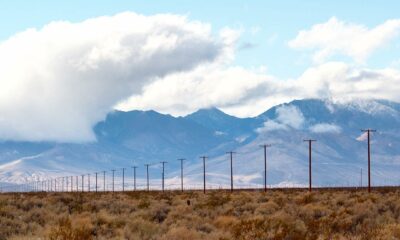Executive
Joe Biden’s Energy Policies Are Based on Fantasies and Fairy Tales

In March, PJM Interconnections, a regional electricity transmission organization (RTO) serving the greater Mid-Atlantic region, released its annual load forecast report outlining forecasted electricity demand for its service area. The report indicates PJM expects demand in their service area to increase as much as 40% over the next 15 years.
Electricity demand collides with switch to unreliable supply
PJM manages the transmission of wholesale electricity across 13 states and the District of Columbia – including major data center hotspots such as Virginia and Ohio.
Meanwhile, a neighboring RTO, the Mid-Continent Independent System Operator (MISO) painted an even gloomier picture in its recent “Reliability Imperative Report.” MISO manages electric transmission across 15 states throughout most of the Midwest, Mississippi Valley, and Great Plains regions as well as the Province of Manitoba in Canada.
In their report, MISO forecasts a demand increase of 60 GW, or 32%, by 2042. At the same time, MISO expects much of their current baseload capacity to retire. And despite new renewable generation planned for construction, MISO expects to see a net capacity decline of 32 GW (@18%).
“Because new wind and solar resources have significantly lower accreditation values than the conventional resources that utilities and states plan to retire in the same 20-year period, the region’s level of accredited capacity is forecast to decline by 32 GW by 2042” MISO stated.
PJM expects 58 GW of current capacity to retire by 2032, which is approximately 30% of the total current capacity of 196 GW). This amount of capacity loss is despite peak forecasted demand increasing by 43 GW above current capacity.
Shutting down generation while demand increases
The story continues to repeat itself across the country. The nation’s existing electric grid is straining to meet the current demand – often nearing the point of failure during the heat of summer and coldest parts of winter. Yet, the Biden Administration remains determined to shut down coal-fired baseload generation facilities — one of the only sources of electricity that has proven itself time and again capable of meeting any demand the grid requires.
Last month, the Biden Administration’s radicalized EPA released its “New Source Performance Standards for GHG Emissions from New and Reconstructed EGUs; Emission Guidelines for GHG Emissions from Existing EGUs; and Repeal of the Affordable Clean Energy Rule.”
The Rule mandates a 90% reduction in carbon emissions from coal-fired power plants that choose the use of Carbon Capture and Storage (CCS) technology and is expected to further reduce coal-fired steam generating unit capacity from 181 gigawatts (GW) in 2023 to 52 GW in 2035, of which 11 GW includes retrofit carbon capture and storage (CCS). This reduction in generation capacity is the result of the probable loss of 660,000 gigawatt-hours (GWh) of coal-fired steam generating units — from 898,000 GWh in 2021 to just 236,000 GWh by 2035. At present, coal-fired generation provides about 20% of the nation’s electricity – but that percentage increases dramatically during the summer and winter months being the peak seasons.
Insane policies
Anyone with even a basic understanding of math or economics can see that forced shutdowns of so much baseload capacity and its replacement with intermittent (read unreliable) wind and solar is sheer insanity. As we have noted in the past, even the Biden Administration’s own energy experts have warned time and again that these closures are already putting our grid at risk of not only short-term blackouts and brownouts – but outright collapse.
In fact, MISO modeling indicates that the region that widespread “load interruptions” of 3-4 hours day for up to 26 or more days a year is possible (perhaps likely), and would happen during the hottest days of summer and the coldest periods of winter, when millions depend on electricity to simply survive.
Biden’s policies are so egregious that 25 states have joined together in a federal lawsuit to stop the plan. They have been joined by labor unions, farmers, manufacturers, and countless others who understand what this reckless policy will do to our economy and the danger it imposes on the American people.
Recently, West Virginia Public Service Commission Chair, Charlotte Lane, explained this concern in a brief filed with the US Federal Court supporting the lawsuit.
Retirement of electricity generating capacity
“The Final Rule does not simply encourage, but effectively mandates, early retirement of coal-fired, baseload, dispatchable generation that is necessary to maintain the reliability and resilience of the electric power grid,” Lane wrote. “…Steam-powered generation [is required] to provide the dispatchable base load power supply to assure constant and consistent electricity supplies twenty-four hours a day, year around, the entire interconnected electrical system will be relying on unreliable intermittent generation sources that cannot be dispatched because the sun does not shine and the wind does not blow 24 hours per day, 365 days a year.”
“I cannot overstate the reliability concerns that are just as critical as the concerns over the costs…” Lane continued. “The EPA’s downplaying of the problem notwithstanding, this move to intermittent resources will be unsafe and unreliable without online reserve resources necessary to provide the constant balance of supply to load when wind and solar resources are intermittent.”
This rule will also drive-up costs for families and businesses across the country – inevitably causing energy poverty on a scale never seen in this country as families are faced with the hard choice of putting food on the table or buying needed medicines or paying their electric bills.
The sun does not shine brightly enough, nor the wind blow hard enough,…
The bottom line is that solar and wind resources are not the panacea radical environmentalists claim them to be. Despite their claims, wind and solar are not less expensive relative to thermal resources.
First, the current thermal generation plants (coal and natural gas) that the rule would close, are up-and-running generation units. Replacement renewable generation capacity, as well as transmission capacity would have to be build (at significant cost). And adding this new capacity is not comparing apples to oranges. It will take multiple times as much replacement generation capacity to replace thermal generation capacity with intermittent and limited-duration wind and solar generation resources.
As Lane noted in her brief, “PJM has quantified the ability of wind and solar resources to serve load for delivery years 2026/27 through 2034/35: replacing 1,000 MW of coal-fired capacity will require either 4,200 MW of onshore wind, 2,500 MW of more expensive offshore wind, 21,400 MW of fixed solar, or 15,500 MW of more expensive tracking solar.”
So, any supposed advantage in costs claimed by the renewables industry and their supporters quickly, flies out the window in the face of reality. Frankly, the policy decisions in the Biden White House are detrimental to the wellbeing of the United States citizens and economy.
This article was originally published by RealClearEnergy and made available via RealClearWire.
Emily Arthun is president and CEO of the Washington, D.C.-based American Coal Council.
-

 Guest Columns4 days ago
Guest Columns4 days agoShe Saved Her Life. 7-Eleven Fired Her
-

 Civilization4 days ago
Civilization4 days agoDemocrats’ Viral Video Lights Match to the Republic
-

 Guest Columns4 days ago
Guest Columns4 days agoWaste of the Day: What’s Big, Grey And Costs $350K?
-

 Civilization3 days ago
Civilization3 days agoThe AI Challenge: Palantir, the Pope, and Paul Kingsnorth
-

 Civilization3 days ago
Civilization3 days agoNo Kings, No Queens, No Blind Loyalty
-

 Civilization2 days ago
Civilization2 days agoThe World Needs to Restore Balance and Objectivity on Climate
-

 Executive3 days ago
Executive3 days agoWaste of the Day: California’s $450 Million 911 Center Doesn’t Work
-

 Civilization2 days ago
Civilization2 days agoFree Speech Requires a Pious Commitment










